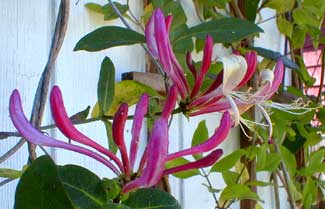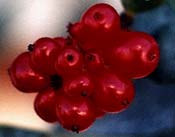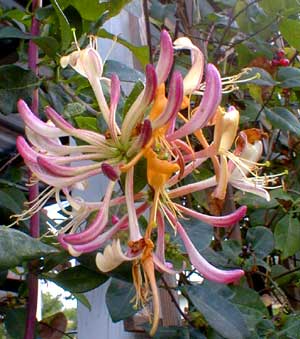 | |
by Dante Gabriel Rossetti (1828-1882) | |
Serotina Honeysuckle,
hummingbirds' delight
Lonicera periclymenum 'Serotina Florida' is a two large-flowering honeysuckle planted in two locations along the wall of the garage out by the alley.
The name 'Serotina Florida' does not mean it is native of Florida, since its natural range is North Africa & in Europe as far north as Sweden, & the specific variety was developed in The Netherlands.
So "Florida" alludes only to the proliferation of blooms. To avoid the easy confusion that it's from the American south, it is more & more commonly just called 'Serotina Honeysuckle.' It's elsetimes called 'Serotina Woodbine' or 'Serotina Honeybush.'
The natural form has white flowers, but Serotina is white & dark red.
Summer fruits ripen serially from July to September, becoming a shiny brightest red. These will last on the vines until well after leaf-fall, though the berries will be rotted & fallen before the start of winter, if not eaten by birds.
 The fruit photo at the right was taken early October (for more fruit photos, see the Serotina Honeysuckle Page of the Berries Gallery). Honeysuckle berries are sometimes said to be poisonous, though certainly not very. A few honeysuckle berries are perfectly safe to eat, such as those of L. caerulea, but I wouldn't hazard Serotina without better advice than mine.
The fruit photo at the right was taken early October (for more fruit photos, see the Serotina Honeysuckle Page of the Berries Gallery). Honeysuckle berries are sometimes said to be poisonous, though certainly not very. A few honeysuckle berries are perfectly safe to eat, such as those of L. caerulea, but I wouldn't hazard Serotina without better advice than mine.It likes full sun to part shade. In warmer climates than ours it is an evergreen, & in colder climates than ours it dies to the ground, but it is hardy to minus 30 degrees F., & mild Puget Sound weather means it keeps many of its leaves a long while into autumn though the leaves eventually all drop. The vining stems themselves do not much die back, providing a pleasing viny tangle of stems for winter its appearance.
When newly planted it should be kept moist, but once established it hardly ever needs watering in places with any degree of rainfall. It needs pruning & training to a trellis, & it may need ground-trailing vines lifted to a trellis or removed. It should be fertilized in spring just before new growth, but is otherwise undemanding. It is somewhat susceptible to powdery mildew, which can be successfuly kept away organically by spraying the leaves occasionally with dilute powdered skim milk.
 The honeysuckle flowers are in full sway in July (they will begin earlier in warmer zones) & last as late as September or until first frost. The gorgeous flowers are extremely fragrant & hummingbirds are very much attracted to such large-flowering honeysuckles.
The honeysuckle flowers are in full sway in July (they will begin earlier in warmer zones) & last as late as September or until first frost. The gorgeous flowers are extremely fragrant & hummingbirds are very much attracted to such large-flowering honeysuckles.When we first bought the house & began planting gardens, for some while we had too little to hold visiting hummingbirds' attention, but year be year we've added more things to appeal to them, not only honeysuckles, but also a couple of big Red Hot Pokers which the hummers also love, sundry varieties of Penstemons, a large red funnel-flowered Trumpet Vine (Bignonia capreolata 'Dragon Lady'), sages, cape fuchsias, bee-balms, hyssops, & much else the hummingbirds love. And when you plant for them, they come!
The many cloned cultivars of L. periclymenum are less aggressive than the wild species, & they are still less aggressive here in the Northwest where the evergreen capacity is not achieved by an otherwise perfectly hardy vine.
It can be hedged quite short & small to create a completely tamed honeybush. But left to its druthers, it will climb & spread to as much as twenty feet high & wide, though ten to fifteen feet is more common for cloned cultivars. It is traditional to have it cover an entire fence or trellis, which it will do very rapidly. Even so, it is nice to know it can be trained to any size to meet just about any need a gardener may want from it.
Regarded by many as a medicinal plant, the flower is used to brew an herbal tea drunk for enjoyment & as a purported remedy for colds & flues, cough, or asthma. The nectar of the flowers themselves are traditionally "sucked through the bottom" of a plucked funnel for a sweet treat, & if there are any herbal toxins in the nectar, it is too little to worry over.
As a final unusual observation: When Serotina is winding its way about, it always does so clockwise. I wonder if honeysuckles turn counterclockwise when grown in Australia?